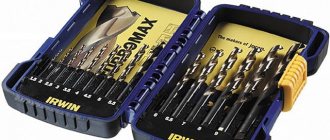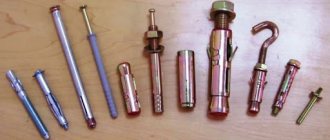Features of drilling tiles
So, what you need to know before you get started:
- How to choose the right tool.
- How not to damage the material.
- How to get the right hole with the perfect shape and size.
The first piece of advice says that it is strictly forbidden to exert increased pressure during work. That is, try not to put pressure on the tile, use a low rotation speed of the drill. Your task is to minimize vibration.
To prevent the tile from overheating, cool your tool from time to time. Take a small bowl or bucket of water into which you will place the overheated part of the tool from time to time. Remember to disconnect the device from the power supply during cooling. Moreover, the tiles also need to be watered.
Such precautions are determined by two qualities of tiles - fragility and slippery surface.
How to prevent chips and cracks
The consequences of incorrect or careless drilling are chips, cracks and scratches on the facing layer of glaze. How to avoid this?
- Wet the tool regularly; if the drill and tile overheat, the risk of cracks and chips increases.
- Pre-wet the tiles in water for 1 hour.
- Step back from the edge of the tile at least 15 mm. Otherwise, it may crack at the seam.
- First, use a center punch to mark the drilling location. It is necessary to remove the layer of glaze in that place so that the drill does not slip on the tile. Another popular option: stick a small piece of tape on the tile, on which the marks will be clearly visible, and the drill will not slip on the tile.
Important! Think about your own health and safe work. Wear glasses and gloves when working, because chipped tiles can get into your eyes, and you can easily cut yourself on the cut edges.
Tools
To drill a hole in ceramics, it is appropriate to use tools such as:
- Hand Drill: The benefits of using a hand drill include the fact that it is easy to handle. In other words, the master completely controls the rotation speed and does not allow vibrations. Thanks to these features, this drill is considered the most suitable for working with tiles;
- Electric drill: since the previous tool is extremely rare, its electric variants are most often used. It is advisable to purchase models in which the rotation speed of the drill is regulated without sudden transitions. For ceramic products, the recommended rotation rate is 1000 rpm;
- Electric jigsaw: it can only be used if there is no other more suitable tool. Makes fairly large holes;
- Screwdriver: Thanks to the special features of working with tiles, the screwdriver has enough power to work with ceramic products. It has a significant advantage - the presence of a battery makes it possible to work in places where there are no power points.
Tips for choosing
Since any tile is a rather fragile product, you need to approach its drilling with the utmost care. First you need to choose a working tool. If one or two small holes are needed, it is preferable to use a hand drill, which does not vibrate during operation. But this option is not suitable for everyone. Then a hand drill without an impact function is used.
Related article: What are anaerobic bacteria and anaerobic infections
The choice of drill is decided depending on the work to be done. It is better to use spear-shaped products when it is necessary to make small holes. When making a purchase, you need to pay attention to the fact that the drill bit must be harder than the working surface. Experts advise choosing diamond-coated products. And although it is somewhat more expensive than other types of drills, its high quality allows it to be used when performing a large volume of work. And to make a couple of holes once a year, you can purchase an inexpensive drill with a Pobedit tip.
Types of drills for ceramics
Spear drills:
- + Affordable price;
- + Long-term operation.
Thanks to the two above-mentioned qualities, such drills are the most in demand today. They are suitable for working with ceramics whose thickness does not exceed 1.2 cm.
When working with ceramic granite, such drills can be used for only 4-5 holes.
Pobedit drills
Pobedit means a special alloy of cobalt and tungsten, which makes this product highly durable and cheap. Their high demand is due to their durability and affordability.
Carbide drills
This product has a one-sided sharpening. The sharp sharpening angle allows it to penetrate into ceramics and other similar materials quite easily. Their diameter does not exceed 1.2 cm.
Ballerina - drill for tiles
When installing the latest, modern lighting system for the bathroom, a ballerina will help you carry out high-quality work.
Indeed, the tile cutter resembles a ballerina drawing circles . Precise, even drilling is guaranteed by durable, metal core bits. Circle radius and depth are controlled. The tip of the drill cuts firmly into the surface, does not slip, does not move.
1 of 2
Ballerina
Basellink installed on an electric drill
Tile cutter - different:
- low price, efficiency;
- high level, wide range of work performed;
- duration of operation.
Note
Please note that using circular rods requires covering the middle of the hole with masking tape.
Drills with diamond chips
Such tools are very expensive due to their high quality and are most often used by professional craftsmen.
The advantages include:
- High strength;
- Compatible with any material;
- High resource;
- Smooth holes after drilling, as the material is not cut.
There are three types of fixation of spraying on the drill:
- Diamond chips on solder: drills with such fixation are more affordable, however, the coating wears off relatively quickly, since when overheated, the solder becomes softer and more pliable.
- Mechanical fixation: the chips are fused into the edge, which is heated with current until it becomes plastic. This drill will last much longer.
- Laser soldering: These drills are considered the most expensive because they last longer than others.
Circular drills “Ballerinas”
The gap between the two “legs” is adjusted using a hex key. The minimum distance is 1.5 cm, the maximum is 4.5 cm. Therefore, when using a ballerina, you can get holes from 3 to 9 cm in diameter.
Feather drills
When using such drills, there is no need to form pinholes on the tiles. The largest diameter of such a drill is 3 cm.
Crowns without diamond chips
Crowns, also called cutters, are cylindrical in shape and made of tool steel.
The pointed parts are attached to one side, and the shank, where the cartridge is attached, is attached to the other.
According to their design, they are distinguished:
- Center drill bits, which are good for hand tools;
- Milling cutters without a center drill - used for stationary installations.
Diamond coated crowns
Tools of this quality are usually used by professional craftsmen. Cutters heat up much faster than drills, so there are two types of methods by which they are sprayed with diamonds:
- Spraying for wet drilling: the chips are fixed on solder. As mentioned earlier, this part heats up faster, which is fraught with loss of coating. To prevent loss of crumbs, it is necessary to supply water to the area of the tile where the work is being done.
- Spraying for dry cutting: such cutters cost much more than the first ones, since the spraying is fixed with laser soldering, which makes them more resistant to overheating.
Large diameter holes
Large holes are made into the tiles before they are installed on the wall or laid on the floor. They are necessary for bringing engineering systems outside - water sockets, sewer pipes, socket boxes, ventilation system duct.
There is no point in drilling them on the wall, since electrical wiring and pipes are installed in the concrete of the wall or behind the false plasterboard panel. There are two types of special tools that allow you to make holes in the cladding very carefully. In the absence of such equipment, you can use a small-diameter drill, a grinder with a diamond blade, or a multifunctional tool.
Crowns
Ceramic crowns for making through holes in tiles are classified according to several criteria:
- presence of a guide element - with and without a central drill; Crown with and without a guide drill.
- type of abrasive – diamond for porcelain tiles, tungsten carbide for ceramic tiles.
Crowns with tungsten carbide.
Tungsten carbide bits are used to cut holes in ceramics. With the same diameter as diamond equipment, their cost is 2–3 times lower. However, the abrasive layer begins to fall off when you try to drill porcelain stoneware.
Tools with a cylindrical shank are considered the cheapest; a hexagonal tip raises the price, but not by much. Drill bits with a shank have the highest price. In addition to ceramics and porcelain stoneware, diamonds confidently and evenly cut glass and mirrors.
Crowns are sold individually and in sets. A tool coated with tungsten carbide Ø33 mm costs 420 rubles, a set of 4 bits (33 mm, 53 mm, 67 mm, 83 mm) with an adapter costs 1600 rubles.
The cost of diamond crowns from domestic and foreign manufacturers starts from 700 rubles. or 1000 rubles, respectively. Depends on the type of shank (SDS+, cylindrical), diameter, shape of the cutting edge (tubular, with cuts), the presence of a centering drill, brand and other factors.
In a set, crowns are cheaper; special devices and accessories are added to them. However, the required tool diameters are rarely available there; you have to buy them individually.
Angle grinder with diamond blade
With a limited budget, a confident angle grinder user will always be able to carefully cut a large-format hole with a diameter of 50 mm or more (a sewer pipe connection) in a tile with a diamond disc.
To do this, use a Ø115 mm disc. The work is performed at an angle to the surface of 45° from the front side of the cladding.
You can partially remove the tiles inside the marked hole using straight cuts. For example, crosswise in the middle, then a square inscribed in a circle.
Then the remnants of the tiles inside the circle are removed with pliers with side jaws.
Angle grinder work can be done from the reverse side of the finishing material. In this case, the markings should be applied symmetrically on both sides of the tile. The tool with the diamond blade rotates evenly in a circle relative to its center. The tiles must be secured with a clamp with a soft pad.
When marking the hole, the gap between the tiles should be taken into account to ensure a standard joint thickness. If you have insufficient experience in using an angle grinder, it is recommended to use a special holder, with the help of which the required offset of the disk relative to the sole of the device is set.
If the hole is not hidden under the ventilation grille or decorative washers of the mixer, the edges must be additionally processed with an abrasive tool - a rasp, a file, or sandpaper attached to a piece of handle.
Multifunctional tool
For particularly precise, critical work with almost any structural and finishing materials, a separate category of power tools has been created. Different manufacturers (or different stores) have different names for them:
- MFI is a multifunctional tool;
- renovator - universal cutter, electric chisel;
- multitool – vibration cutter, multimaster, oscillating tool.
The principle of operation is similar to a delta grinder, the dimensions are much more compact:
- the renovator spindle fluctuates within 3 – 4° relative to the central axis;
- vibration frequency is 10,000 – 25,000 min-1;
- Several types of attachments are used for wood, ceramics, metal, and plastic.
There are network and battery-powered versions of MFIs that allow you to make holes of any size and shape in the tile before and after gluing it to the wall. With equal success, the renovator connects a heated towel rail or attaches a wall shelf.
Diamond disc for renovator.
For tiles and porcelain tiles, diamond-coated segment saw blades are used. Or hammer-shaped, teardrop-shaped attachments.
Engraver
Another highly specialized tool for precision work, often found in the arsenal of a home craftsman, is a miniature drill - an engraver.
This power tool can be used independently - the equipment is mounted in a collet clamp, or with a flexible shaft.
Moreover, flexible shafts for drills and sharpening machines with emery wheels are available for sale.
By analogy with MFIs, the industry produces a huge number of attachments for engravers. However, they cut material due to rotation, not vibration. To make holes with an engraver, it is most convenient to use a device that turns this power tool into a miniature analogue of a router.
Engraver with a device for milling holes.
Use a tile bit (Dremel part number 562) or a diamond blade (DSM part number 540).
Due to the high strength of the hardened porcelain stoneware layer, the tool life is reduced compared to drilling ceramic tiles.
Drilling around the perimeter
When installing an electrical or water outlet in the absence of an angle grinder, crowns, engraver and other special tools, you can use a drill with a spear-shaped, tubular, small-diameter Pobedit drill:
- after marking the circle, a large number of holes are drilled from the inside of the line close to each other;
Making holes with a drill around the perimeter. - the inside of the tile is knocked out;
Removing the inside of the tile. - after which, all that remains is to break off large irregularities with pliers; Removing large irregularities with pliers.
- at the last stage, the edge is processed with an abrasive tool or file.
Sanding the edge with sandpaper.
Attention: This method is not recommended for making holes close to the edge of the tile, as the lining may break off.
Ballerina
A special tool for making holes in ceramic tiles - a ballerina - is available as an attachment on some manual tile cutters or is sold separately as an accessory for an electric drill.
In any case, destruction of the facing material occurs when the cutter rotates around the central guide. The process is long, dusty, and the resulting material may crack.
Recommended drill speed is 200 - 500 min-1, the tile is attached to the sheet material with a clamp, water is added to the groove.
Ceramic tile drilling technology
To make holes in the tiles, perform the following steps:
- Firstly, the drill is switched to a special mode, unstressed. Secondly, the required drill with the appropriate diameter is placed in the chuck. Thirdly, to prevent the tile from cracking when drilling concrete with a hammer drill, the hole on the ceramic element must be larger than in the concrete.
- Before gluing, the material must be immersed in water for an hour.
- Marking is being carried out. The location must be selected in such a way that the edges of the hole and the tile are more than 1.5 cm apart from each other.
How to drill tiles
Having a set of drilling tools in your arsenal is not all the conditions for obtaining beautiful holes. It is also very important to learn how to drill materials correctly. To do this, you should know well and take into account some of the features of each material. Ceramics and glass are very fragile materials. To drill them, you need a device with several operating modes. A familiar screwdriver operating at low speeds is quite suitable for this work. A hole in glass or ceramic tiles is formed as a result of friction between elements containing abrasive substances. During work, the surfaces become quite hot, which can cause their destruction. It is recommended to cool them with water.
The minimum pressure on the drill is needed so that the material does not collapse. But too little pressure can be completely useless. Reverse cannot be turned on when drilling either. If the tiles are already on the wall, it is better to choose tile joints for the holes. If the material is not yet glued, it can be soaked in water for 20-30 minutes, then marked with a felt-tip pen. It is good to glue masking tape or a medical plaster to the place of the future hole. It will not allow the drill to move to the side.
Drilling is usually carried out at a speed of about 180 revolutions of the working shaft. The drill or screwdriver is held in a perpendicular position relative to the plane of the tile. As soon as the surface layer of the tile is destroyed, the number of revolutions can be slightly increased. Periodically, the tool needs to be stopped and placed in water to cool. After this, the drill is wiped off and the drilling process continues. Chips and dust must be removed from the work site in a timely manner. A vacuum cleaner works well for this. Wearing safety glasses is recommended to protect your eyes from particles of material.
Photos of the best tile drills
Spear drill bit for tiles
How to drill into tiles with a spear drill? Drilling is carried out at low speeds. The processing is carried out with high quality, insured against cracks.
Indispensable when creating holes for dowels and finishing porcelain stoneware surfaces. Thanks to the spear-shaped sharpening, it has high efficiency and productivity. With proper use, a long service life is guaranteed.
Tungsten wire cutting
To make a neat hole in the tile without the risk of splitting and damaging the material, it is better to use a hand tool rather than a power tool. To do this, you need to buy a tungsten string from a hardware store, which is inserted into the saw instead of the cutting blade. The cutting process is performed in the following order:
- Markings of the future outlet are applied to the outer or inner surface of the tile.
- If the hole is located inside the tile, then inside the marked circle you need to make a hole of small diameter using a Pobedit drill and a drill.
- A tungsten cutting wire is inserted into the hole made by a drill in the tile.
- With the help of a string, a hole is cut along the markings using forward-returning movements.
This is interesting: How to lay and glue mosaic tiles in the bathroom yourself
Tungsten wire cutting
Note! When cutting tiles with a tungsten wire, cracks, chips or other defects never occur. However, it takes up to 30 minutes to make each hole manually, so this method is not suitable for industrial scale.
Cutting with a thin pobedit drill
It happens that the master does not have special tools for cutting tiles in his arsenal, but the work needs to be done urgently. Then a drill with a regular Pobedit drill with a diameter of 6-8 mm comes to the rescue. The process of making holes using this method is as follows:
- The socket box is placed on the outside of the tile and then outlined using a marker or pencil.
- About 20 holes with a diameter of 8-8 mm are made along the marked circle in increments of 1-2 mm.
- The isthmuses between the holes are carefully removed using pliers or wire cutters.
Cutting with a pobedite drill bit
Important! Marking and drilling of tiles should be done only from the outside of the material, otherwise the cut location will look sloppy.
What to consider when drilling into ceramics
If you need to carry out drilling work on tiles, you should choose the right model of electric drill. Suitable models are those that can operate at low speeds and in which the impact drilling mode is absent or can be turned off. Thus, in order to drill a hole in ceramic tiles with high quality, the following devices are optimally suited:
- electric drills that can operate at a minimum rotation speed of the cutting tool;
- cordless screwdrivers, the maximum rotation speed of which does not exceed 800–1000 rpm;
- low-speed screwdrivers operating from the central electrical network.
The main types of drills for tiles
A drill for tiles or ceramic tiles differs in its design from the tool used for drilling any other material. Processing of tiles using a special drill is carried out due to the friction forces created by the abrasive material applied to the working surface of the tool. The working part of a drill for ceramics or any other similar materials can have an arrow-shaped or crown-shaped configuration. In such situations, a tool with an adjustable processing diameter, which is commonly called a ballerina, is also often used.
When performing drilling work on ceramic tiles, it is important to adhere to certain rules that will allow you to obtain a high-quality result:
- It is necessary to constantly monitor the temperature of the drill and the ceramic tile being processed, since overheating can lead to failure of the tool and the appearance of cracks on the surface of the product. To prevent overheating, the processing area and drill must be periodically watered.
- The pressure exerted on the drill when working on ceramics should not be too weak (in which case it will not be possible to drill through the tiles) and too strong (this may lead to breakage of the workpiece).
- The drill should rotate slowly and only clockwise; reverse mode cannot be used, as this can lead to cracking of the tiles.
- In the event that it is necessary to drill not in the tile itself, but in the gap between two adjacent products, the drill should be placed strictly in the middle of the seam between the tiles. You should drill holes very carefully if they are located in close proximity to such a seam. In this case, the drill can easily slip into the seam, and it will not be possible to get a hole in the required place. It should also be taken into account that at the edges of the tile the thickness of the protective layer applied to it is minimal (or there is none at all), so when drilling in such places, pieces of material may break off from the tile.
Painting tape pasted before marking will help make the hole more accurate.
Very often you can find advice on preliminary punching the surface of the tile in the place where it is necessary to drill a hole. The design of modern drills used for tile work is designed in such a way that there is no need to perform this procedure, which can easily lead to breakage of the product.
One of the main rules: no matter what drill you use, it should always be sharp.











